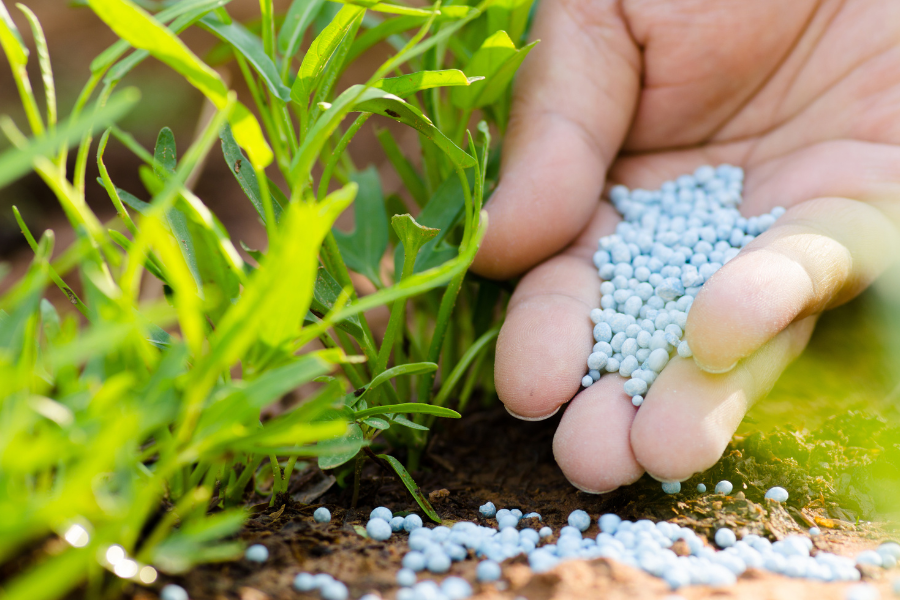Fertilizers Testing:
 The role of fertilizers cannot be ignored in agriculture. These are the compounds that are given to the soil to help nurture the plant facilitating increased yields.
The role of fertilizers cannot be ignored in agriculture. These are the compounds that are given to the soil to help nurture the plant facilitating increased yields.
 Fertilizers are chemical compounds or substance that contain elements which are necessary for the growth of plant and flowers. There are mainly two types of fertilizers organic and inorganic. Organic fertilizers are those which are made through natural process like decomposed plants such as manure, worm castings, peat moss, seaweed, sewage and guano, whereas inorganic fertilizers are manufactured through chemical process. They are in the form of simple compounds mainly of nitrogen, phosphate and potash. Below are different types of fertilizers used in the agriculture industry.
Fertilizers are chemical compounds or substance that contain elements which are necessary for the growth of plant and flowers. There are mainly two types of fertilizers organic and inorganic. Organic fertilizers are those which are made through natural process like decomposed plants such as manure, worm castings, peat moss, seaweed, sewage and guano, whereas inorganic fertilizers are manufactured through chemical process. They are in the form of simple compounds mainly of nitrogen, phosphate and potash. Below are different types of fertilizers used in the agriculture industry.
Bio Fertilizer, Chemical Fertilizer, Agriculture Fertilizer, Urea Fertilizer, Compost, Organic Fertilizer Organic Manure etc.,
A. pH B. Appearance C. Specific gravity. D. Viscosity( Liquid Fertilizer) :
| Sl No | Description |
|---|---|
| I | Moisture per cent by weight, maximum |
| Ii | Total Nitrogen per cent by weight, minimum |
| Iii | Water soluble phosphates (as P2O5 ) per cent by weight, minimum |
| iV | Water soluble potash per cent by weight, minimum |
| V | Total Chloride, per cent by weight, maximum |
| Vi | Matter insoluble in water per cent by weight,maximum |
| Vii | Sodium as NaCl, per cent by weight,maximum |
| Viii | Lead (as Pb ) per cent by weight,maximum |
| Ix | Cadmium (as Cd) per cent by weight,maximum |
| X | Arsenic (as As) per cent by weight,maximum |
SOIL TESTING:
 Soil and Water are the most important natural resources that support and provide nutrients to plants and animals for our survival. It also buffers much of our waste materials helping to correct and often hide many of our mistakes and oversights.
Soil and Water are the most important natural resources that support and provide nutrients to plants and animals for our survival. It also buffers much of our waste materials helping to correct and often hide many of our mistakes and oversights.
Soil testing is the Chemical analysis that provides a guideline for lime and fertilizer needs of soils when considered in conjunction with post-fertilizer management and cropping history. Although plant analysis is extremely valuable in diagnosing nutrient stress, analysis of the soil is essential in determining the supplemental nutrient requirement of crop. It refers to the chemical testing of soils for evaluating the fertility status and nutrient supplying power with respect to the application of fertilizers.
It includes the analysis of available N, P, K and micronutrients, texture, pH, CaCO3 content and the parameters related to the amelioration of the chemically deteriorated soils.
| Sr No. | Sample Name | Scope | Test Analytes |
|---|---|---|---|
| 1 | Soil FCO 1985 | Chemical | pH |
| 2 | Electrical Conductivity | ||
| 3 | C:N Ratio | ||
| 4 | Clay Content | ||
| 5 | Macronutrient | Carbon | |
| 6 | Phosphorus as P | ||
| 7 | Potassium as K | ||
| 8 | Nitrogen as N | ||
| 9 | Sulphur | ||
| 10 | Magnesium as Mg | ||
| 11 | Micronutrients | Boron as B | |
| 12 | Copper as Cu | ||
| 13 | Manganese as Mn | ||
| 14 | Iron as Fe | ||
| 15 | Zinc as Zn | ||
| 16 | Nickel | ||
| 17 | Molybdenum | ||
| 18 | Chlorine | ||
| 19 | Calcium | ||
| 20 | Microbial | Total Plate Count | |
| 21 | Total Fungal Count |
The Soil testing is done with the following objectives:
# To optimize crop production
# To protect the environment from contamination by runoff and leaching of excess fertilizers # To aid in the diagnosis of plant culture problems.
# To improve the soils’ nutritional balance
#To save money and conserve energy by applying only the amount of fertilizer needed.
#To identify soils contaminated with lead or other heavy metals.


Testing
Read More
Inspection
Read More
Certification
Read MoreTesting Services
- Drugs & Pharmaceutical Testing
- Cosmetics & Essential Oils Testing
- Medical Devices Testing
- Ayush - Ayurvedic Drug Testing
- Food Products Testing
- Agri Commodities Testing
- Fertilizers and Soil Testing
- Animal Food & Feed Testing
- Water - Drinking Water & Effluent Water Testing
- Industrial Oils and Lubricants & Petroleum Products Testing
- Coal & Coke and Solid Fuels Testing
- Ores & Minerals Testing
- Metals & Alloys Testing
- Plastics, Polymer, Rubber & Rubber Products Testing
- Resins & Adhesives Testing
- Paints, Varnish, Pigments & Surface Coating Testing
- Glass & Ink, Paper & Pulp Testing
- Industrial & Fine Chemicals Testing
- Dyes, Acids and Solvents Testing
- Soaps, Detergents & Toiletries Testing
- Packaging & Packaging Products Testing
- Gold & Silver Assaying & Hallmarking
- Cement, Concrete & Building Materials Testing
- Pollution and Environmental Studies
- Microbiological Assays. Etc.,









